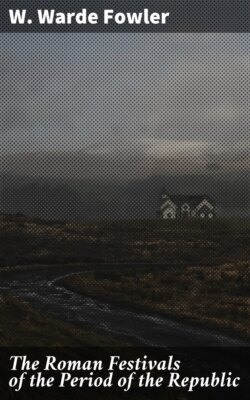Читать книгу The Roman Festivals of the Period of the Republic - W. Warde Fowler - Страница 23
ix Kal. Apr. (March 24). NP.
ОглавлениеQ. R. C. F. (VAT. CAER.)
Q. REX. C. F. (MAFF. PRAEN.)
Note in Praen.: HUNC DIEM PLERIQUE PERPERAM INTERPRETANTES PUTANT APPELLAR[I] QUOD EO DIE EX COMITIO FUGERIT [REX: N]AM NEQUE TARQUINIUS ABIIT EX COMITIO [URBIS], ET ALIO QUOQUE MENSE EADEM SUNT [IDEMQUE S]IGNIFICANT. QU[ARE COMITIIS PERACTIS IUDICI]A FIERI INDICA[RI IIS MAGIS PUTAMUS][178].
These two days must be taken in connexion with the 23rd and 24th of May, which are marked in the calendars in exactly the same way. The explanation suggested by Mommsen is simple and satisfactory[179]; the 24th of March and of May were the two fixed days on which the comitia curiata met for the sanctioning of wills[180] under the presidency of the Rex. The 23rd in each month, called Tubilustrium, would be the day of the lustration of the tubae or tubi used in summoning the assembly. The letters Q. R. C. F. (quando rex comitiavit fas) mean that on the days so marked proceedings in the courts might only begin when the king had dissolved the Comitia.
The tuba, as distinguished from the tibia, which was the typical Italian instrument, was a long straight tube of brass with a bell mouth[181]. It was used chiefly in military[182] and religious ceremonies; and as the comitia curiata was an assembly both for military and religious objects, this would suit well with Mommsen’s idea of the object of the lustration. The Tubilustrium was the day on which these instruments, which were to be used at the meeting of the comitia on the following day, were purified by the sacrifice of a lamb. Of the Atrium Sutorium, where the rite took place, we know nothing.
There are some words at the end of Verrius’ note in the Praenestine Calendar, which, as Mommsen has pointed out[183], come in abruptly and look as if something had dropped out: ‘Lutatius quidem clavam eam ait esse in ruinis Pala[ti i]ncensi a Gallis repertam, qua Romulus urbem inauguraverit.’ This clava must be the lituus of Romulus, mentioned by Cicero[184], which was found on the Palatine and kept in the Curia Saliorum. We cannot, however, see clearly what Verrius or his excerptor meant to tell us about it; there would seem to have been a confusion between lituus in the sense of baculum and lituus in the sense of a tuba incurva. The latter was in use as well as the ordinary straight tuba[185]; in shape it closely resembled the clava of the augur, and perhaps the resemblance led to the notion that it was the clava of Romulus and not a tuba which was this day purified with the other tubae.
We can learn little or nothing from the calendar of this month about the origin of Mars, and we have no other sufficient evidence on which to base a satisfactory conjecture. But from the cults of the month, and partly also from those of October, we can see pretty clearly what ideas were prominent in his worship even in the early days of the Roman state. They were chiefly two, and the two were closely connected. He was the Power who must be specially invoked to procure the safety of crops and cattle; and secondly, in his keeping were the safety and success of the freshly-enrolled host with its armour and its trumpets. In short, he was that deity to whom the most ancient Romans looked for aid at the season when all living things, man included, broke into fresh activity. He represents the characteristics of the early Roman more exactly than any other god; for there are two things which we may believe with certainty about the Roman people in the earliest times—(1) that their life and habits of thought were those of an agricultural race; and (2) that they continually increased their cultivable land by taking forcible possession in war of that of their neighbours.
